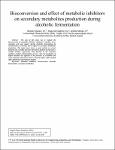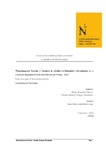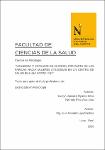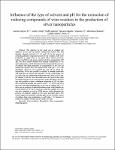Mostrar el registro sencillo del ítem
Bioconversion and effect of metabolic inhibitors on secondary metabolites production during alcoholic fermentation [Bioconversión y efecto de inhibidores metabólicos sobre la producción de metabolitos secundarios durante la fermentación alcohólica]
| dc.contributor.author | Vejarano, Ricardo | |
| dc.contributor.author | Gil-Calderón, Angie | |
| dc.contributor.author | Morata, Antonio | |
| dc.date.accessioned | 2021-06-19T00:34:22Z | |
| dc.date.available | 2021-06-19T00:34:22Z | |
| dc.date.issued | 2019-09-17 | |
| dc.identifier.citation | Vejarano, R., Gil, A. & Morata, A. (2020). Bioconversion and effect of metabolic inhibitors on secondary metabolites production during alcoholic fermentation [Bioconversión y efecto de inhibidores metabólicos sobre la producción de metabolitos secundarios durante la fermentación alcohólica]. Proceedings of the LACCEI International Multi-conference for Engineering, Education and Technology, (168). https://doi.org/10.18687/LACCEI2019.1.1.168 | es_PE |
| dc.identifier.uri | https://hdl.handle.net/11537/26889 | |
| dc.description.abstract | ABSTRACT The aim of this study was to evaluate the bioconversion of metabolic inhibitors (furfural, o-vanillin, transcinnamic acid and copper) during alcoholic fermentation by Saccharomyces cerevisiae, and its effect on secondary metabolites production. The tested yeast shows a good activity to convert furfural and o-vanillin into their derivatives furfuryl alcohol and ovanillyl alcohol, respectively, both detected in the respective mediums at final of fermentative process. Also, the production of higher alcohols was affected in the presence of o-vainillin and trans-cinnamic acid, and to a lesser extent of copper, with a marked effect obtained by discriminant analysis. | es_PE |
| dc.description.abstract | RESUMEN El objetivo del estudio fue evaluar la bioconversión de inhibidores metabólicos (furfural, o-vainillina, ácido transcinámico y cobre) durante la fermentación alcohólica por Saccharomyces cerevisiae, y su efecto sobre la producción de metabolitos secundarios. La levadura mostró buena actividad para convertir furfural y o-vainillina en sus derivados alcohol furfurílico y alcohol o-vainíllico, respectivamente, detectados en los respectivos medios tras el proceso fermentativo. Así mismo, la presencia de ovainillina y ácido trans-cinámico, y en menor medida de cobre, afectó la producción de los alcoholes superiores, con un marcado efecto obtenido mediante análisis discriminante. | es_PE |
| dc.format | application/pdf | es_PE |
| dc.language.iso | spa | es_PE |
| dc.publisher | LACCEI | es_PE |
| dc.rights | info:eu-repo/semantics/openAccess | es_PE |
| dc.rights | Atribución-NoComercial-CompartirIgual 3.0 Estados Unidos de América | * |
| dc.rights | Atribución-NoComercial-CompartirIgual 3.0 Estados Unidos de América | * |
| dc.rights.uri | https://creativecommons.org/licenses/by-nc-sa/3.0/us/ | * |
| dc.source | Universidad Privada del Norte | es_PE |
| dc.source | Repositorio Institucional - UPN | es_PE |
| dc.subject | Fermentación | es_PE |
| dc.subject | Metabolismo | es_PE |
| dc.subject | Etanol | es_PE |
| dc.subject | Microbiología | es_PE |
| dc.title | Bioconversion and effect of metabolic inhibitors on secondary metabolites production during alcoholic fermentation [Bioconversión y efecto de inhibidores metabólicos sobre la producción de metabolitos secundarios durante la fermentación alcohólica] | es_PE |
| dc.type | info:eu-repo/semantics/conferenceObject | es_PE |
| dc.publisher.country | US | es_PE |
| dc.identifier.journal | Proceedings of the LACCEI International Multi-conference for Engineering, Education and Technology | es_PE |
| dc.subject.ocde | https://purl.org/pe-repo/ocde/ford#2.11.00 | es_PE |
| dc.description.sede | Trujillo San Isidro | es_PE |
| dc.identifier.doi | https://doi.org/10.18687/LACCEI2019.1.1.168 |







